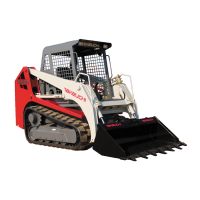
Do you have a question about the Takeuchi TL230 and is the answer not in the manual?
| Brand | Takeuchi |
|---|---|
| Model | TL230 |
| Category | Compact Loader |
| Language | English |
Comprehensive safety guidelines covering clothing, fire safety, signal persons, operating practices, and hazard avoidance.
Steps to take before operation, including work area inspection, cleaning, and operator compartment safety.
Procedures for safe engine starting, including pre-start checks and cold climate considerations.
Critical safety measures during operation, covering visibility, riders, body position, travel, slopes, and loads.
Guidelines for safely parking the machine, including brake application and engine shutdown.
Procedures for safe loading, hoisting, securing, and road transport of the machine.
Safety measures for performing maintenance, including tool usage, component handling, and system pressure.
Identification and importance of safety signs placed on the machine for operator awareness.
Labels and identification of key external machine components for easy reference.
Information on cab doors, windows, emergency exits, and fuse box for operator access and safety.
Instructions for adjusting and securing the operator's seat and seat belt for safe operation.
Overview of warning lamps, indicators, meters, and the multi-data display for machine status.
Usage of ignition, hydraulic, travel, and engine controls including switches and levers.
How to use optional accessories like the air conditioner, power socket, and radio.
Steps to take before starting operation, including getting on/off, inspections, and area checks.
Procedures for safely starting, warming up, and stopping the engine.
How to operate the machine using controls, including lever patterns, traveling, and working equipment.
Guidelines on prohibited operations, specific work techniques, and warnings for various conditions.
Safe parking procedures, post-operation checks, and guidelines for extended storage.
Precautions for operating in cold climates and handling rubber tracks.
Safe methods for loading and unloading the machine onto a transporter.
Proper techniques for hoisting and securing the machine during transport.
Essential information on keeping the machine clean, fluid handling, and general maintenance cautions.
Technical data, lists of parts, tools, schedules, and specifications for maintenance.
Procedures for regular inspections, including walk-around, daily, and interval-based checks.
Maintenance tasks for key components like engine oil, filters, belts, and cooling systems at specified intervals.
Procedures for specific tasks like attachment replacement, canopy tilting, and extended storage.
Identification of normal operating symptoms and common issues not requiring repair.
Troubleshooting for engine overheating, battery failure, blown fuses, and warning lamp indicators.
Solutions for issues like stiff controls, insufficient equipment force, and machine veering.
Steps for lowering lift arms and towing the machine safely when encountering difficulties.
Key technical data including mass, performance metrics, and engine details.
Physical dimensions and operational specifications like reach, height, and turning radius.
General safety advice for installing, operating, and handling optional attachments.
Procedures for using hydraulic quick-hitches and quick-couplers for attachments.
Information on optional equipment like the seat switch function and mass of accessories.